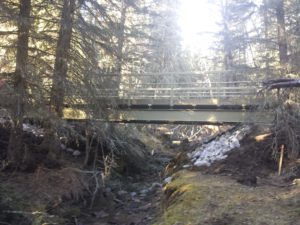A pedestrian bridge is often one of the most visible parts of a development, showcasing the park or trail and giving it a distinctive personality.
Therefore, you need to know what the types of pedestrian bridges are so you can plan for a bridge that you’re proud of and will serve the needs of its users.
Pedestrian bridges fall into 4 general categories:
- Truss
- Girder (Beam)
- Arch
- Long span
Truss
This type of pedestrian bridge can be built at almost any site. They can be built in span ranges from 30 ft (10 m) to about 200 ft (67 m). They can be built to any width, and can be designed to accommodate vehicles as well.

This bridge at the Nanton Golf Course in Alberta, Canada was designed for tandem axle dump trucks as well as golf carts.
They are generally made out of steel. Although wooden trusses can be built, the relative weakness of the connections would limit the bridge spans to somewhere in the range of about 60 ft (20 m) unless large members are used. Composite materials like Fibre Reinforced Polymer (fibreglass) can be used as well. They allow for span lengths similar to steel but because only bolted connections are possible (no welding) the truss options are somewhat limited.
The options for the deck are:
- Wood is generally the cheapest but needs to be replaced about every 15 years.
- Steel grate is still relatively affordable but its transparency can be uncomfortable for some users.
- Concrete is fairly expensive and has a high dead load (self weight) which could require a larger truss (more cost), however it is very aesthetic.
- Asphalt has the same pros and cons as concrete. The cost is also similar, but the only difference is a stronger skid resistance for vehicle tires.
When the primary use is for pedestrians, trusses should be built with a slight camber (upward bow) to ensure the bridge never contains a downward bow under loading. A downward bow creates an alarming situation for the travelling public, even if the bridge is not actually in danger of failing. It also allows for more water flow or vehicle clearance underneath the bridge.
Ideally, trusses are fabricated in the plant and delivered to the site as one piece. However, in some cases the bridge is too long or must otherwise be assembled at site. This does not result in any structural issues but a small additional cost (approx. 10%) must be factored in to account for the additional bolts, welding, and installation.
Girder (Beam)

This backcountry trail bridge in Kananaskis Country, Alberta was transported to the site in pieces and assembled on site.
Most highway and city bridges are built with girders (beams) spanning the opening and a deck placed perpendicularly over it. The load is taken by the girders, underneath the traffic. The side railing is not a structural element; It simply keeps the traffic on the bridge.
This type of pedestrian bridge can be built any length, width, deck type, or material, from a small creek bridge to a large highway bridge. Technically, a log placed across a stream is a girder.
There is no real restriction on the number of girders, width, deck type, or railing type. All of the options can be built relatively easily with only the cost being the major differentiator.
The cost of girder bridges increases exponentially with their size. That is, the longer the span, the bigger the girders need to be, and hence the bigger the cost per square foot of bridge. To put it another way, the amount of steel under each square foot is higher if the girders are larger. At a length of roughly 40 ft (13 m), plus or minus, girder bridges usually approach their prohibitive cost point for most applications. A pier can be built to limit the span, but naturally this comes with a corresponding cost as well.
Arch
Arch bridges can be very aesthetic. They consist of corrugated steel or precast concrete plates on cast-in-place foundations, and they require good quality backfill around the structure. This type of pedestrian bridge can have an aesthetic retaining wall on the outside face, rock riprap, or just grass.
Arches can make excellent pedestrian structures but they are not always an option. Depending on the geometry of the site, an arch might require importing alot of gravel backfill. It might also be a very long, dark structure for pedestrians.
Manufacturers of arches will generally include the design of the structure in their prices to supply the structure. However, they will not do any design outside of the “backfill envelope,” that is, site plans or the like. If you need anything more than a structural design of the structure and related backfill, their insurance requirements will force them to decline and you will need to hire an engineer.
Long Span
 The final category of pedestrian bridge is called long span, and it encompasses several other bridge types that apply only to large and long bridges. This category includes:
The final category of pedestrian bridge is called long span, and it encompasses several other bridge types that apply only to large and long bridges. This category includes:
- Cable stayed bridges
- Suspension bridges
These types of bridges are very aesthetic and make for a memorable structure, but they are expensive. These types of bridges require significant design and construction resources and must be planned for years in advance.


Speak Your Mind